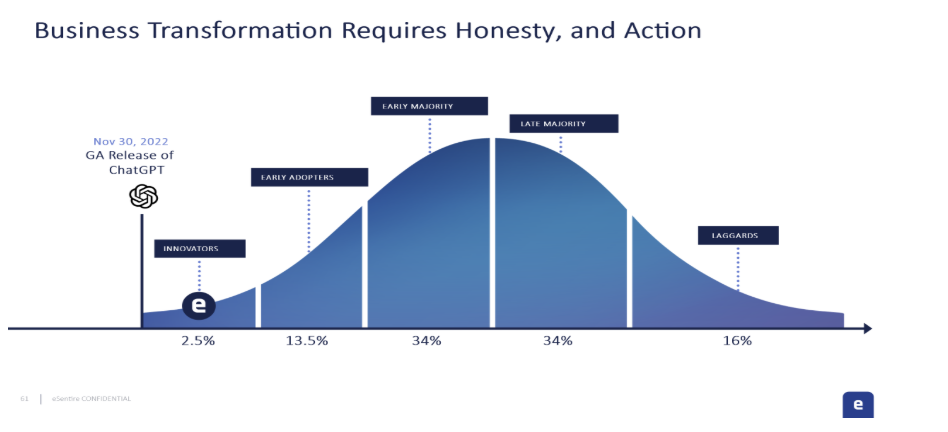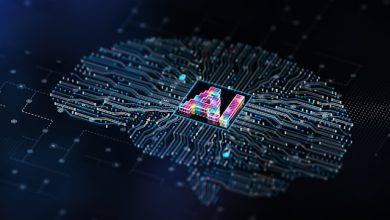
Over the past year, any time I’ve spoken to security leaders – either on conference floors or when they visit our office headquarters for a Security Operations Center (SOC) tour – one topic inevitably comes up and that’s AI. What’s top of mind for everyone is secure AI adoption at their organizations, how they can build a more effective security program with AI, and most importantly, how they can protect their organizations from AI-based threats.
When considering how much AI has already reshaped the cybersecurity industry, let’s look at it through the lens of the innovation adoption curve to better understand how organizations and individuals will embrace change.
From the adventurous innovators to the cautious majority and the reluctant laggards, each group reacts differently to AI-driven advancements. Recognizing where your business lies on this curve is essential. It shapes how you adopt, adapt, and ultimately succeed in this new AI era.
Cybersecurity leaders are standing at a pivotal moment in the evolution of the security industry. The AI era is no longer on the horizon – it’s here, reshaping how threats emerge and how organizations must protect those threats. To successfully navigate this transformation, organizations must lead with transparency, and partnership. This means focusing on changing company culture to embrace AI fully, empowering teams with the enablement, training, and tools necessary to harness automation and intelligence effectively. We know that trust and validation remain critical: AI is not a silver bullet but a force multiplier that requires proven, transparent, and explainable outcomes.
However, leadership in the AI era also requires embracing a hard truth: not everyone will make the leap. Some individuals or even entire teams will struggle with change, despite best efforts. Leaders have the responsibility to create the conditions for success by providing training, coaching, and encouragement.
It is important to empower your people to embrace AI but also recognize when resistance persists. That’s okay. The role of leadership is not to pull everyone across the finish line, but to set the pace, provide clarity, and move forward with those who are ready to innovate.
In the tech industry, one thing is clear: Disruption does not pause for hesitation, and organizations cannot afford to stall.
Cybersecurity in the AI era demands AI-first security operations and human-backed trust. This means equipping every member of our team with the skills and confidence to integrate AI-driven tools while maintaining oversight and accountability.
When people don’t adopt these innovations, or organizations fail to provide the right support, we all fail. But when we collaborate as partners in this evolution, success follows.
Recommendations for the C-Suite to Foster an AI-First Culture
1. Assess and Acknowledge Your Position on the AI Adoption Curve
Perform anonymous surveys and leader-led assessments to understand where your company and people stand: innovators, early adopters, majority, or laggards. This framing helps tailor strategies for adoption, communication, and investment, ensuring no one is left behind from the opportunity to embrace AI.
2. Lead with Clear AI Governance and Ethical Principles
Establish an AI governance council chaired by the CEO in partnership with your CISO or top internal security leader to define responsible AI policies, manage risks, and ensure transparency. This creates trust with employees, customers, and partners. Implement new reviews on software adoption and headcount asks. Have we exhausted automation options before investing differently? Ask if there is a better, more agentic way to engage in whatever the activity may be, or if a human expert is required to truly differentiate or augment the outcome.
3. Prioritize Human-Centered Leadership and Culture
Foster an organizational culture that values human-AI collaboration. Equip your workforce with training and tools and openly share leadership’s own AI learning journeys to model adoption and experimentation.Myorganization has initiated 2-week team sprints to evaluate and refine process workflows, leading by example and helping with personalized training efforts.
4. Integrate AI Into Strategic Business Goals
Link AI efforts to operational efficiency, enhanced customer experience, and new business models. Align AI initiatives with enterprise KPIs and ensure cross-functional collaboration, especially between CIO, CISO, and business units. Celebrate these wins as a team in videos, chats, and all-hands sessions.
5. Build Agility and Experimentation into AI Deployment
Encourage rapid testing, failing fast, and iterative learning with AI tools. Avoid model lock-in by supporting experimentation with multiple AI technologies and adapting based on real-world outcomes. Acknowledge that you’re on this journey together and that you want feedback to make the outcomes as successful as possible for the team, our partners, and customers.
If you lead a team or an organization, ask yourself: where is your organization on the AI adoption curve? Are you investing in your people as much as your technology? Are you fostering trust and clarity around AI’s role in your security posture? Disruption doesn’t wait. It doesn’t slow down. And it favors those who learn, lead, and align faster than the disruption can outpace them.
The future of cybersecurity is unfolding now. Together, we will navigate this transition, delivering security powered by AI, validated by humans, and grounded in partnership.
Author
Erin McLean is Chief Marketing Officer at eSentire, leading the global marketing and communications strategy. An Olympian and recognized industry leader, she was named one of the Top 100 Women in Cybersecurity and is passionate about inspiring the next generation of women in tech.






